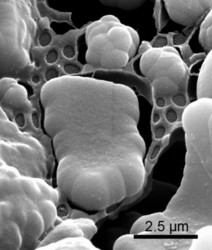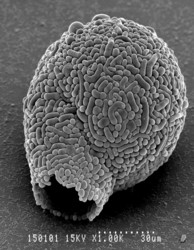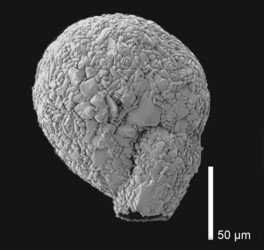Lesquereusia
Ralf Meisterfeld and Edward MitchellIntroduction
This genus was erected by Schlumberger (1845) and obviously named after the swiss naturalist Lesquereux. By lapsus it was first published as Lecqereusia. The currently used spelling was introduced by Hopkinson (in Cash & Hopkinson, 1909)!
Characteristics
The tests are characterised by an asymmetrical neck which is more or less attached to the body. Depending on the species the agglutinate test is either composed of endogenous siliceous rods or other collected mineral particles or a mixture of both. The idiosomes or xenosomes are always fixed by a structured mesh-like cement (Fig. 1). All Lesqereusia spp. have an ovular nucleus. 16 species have been described, type species: Lesquereusia spiralis (Ehrenberg, 1840). Species differ mainly in shape of the siliceous rods, the amount of mineral particles used and the orientation of the neck. Stump (1959) and Freeman (1974) have studied the mitosis in cultured material and the cytology (TEM and cytochemistry) has been studied by Harrison et al. (1975, 1976).


Fig. 1: Structured cement of Lesquereusia modesta . © Ralf Meisterfeld
Habitat: Peryphyton, aquatic mosses or sediments. Feeding: herbivore (diatoms, green algae).
References
Thomas, R. & Gauthier-Lièvre, L. 1959a. Le genre Lesque¬reusia Schlumberger 1845 (Rhizopodes testacés). Bull. Soc. Hist. Nat. Afr. Nord, 50:34-83 , Pl. I, II.
Thomas, R. & Gauthier-Lièvre, L. 1961. Addenda et corrigenda le genre Lesquereusia Schlumberger. Bull. Soc. Hist. Nat. Afr. Nord, 52:162-163.
Ogden, C. G. & Hedley, R. H. 1980. An Atlas of Freshwater Testate Amoebae. Oxford University Press, Oxford.
Stump, A. B. 1959. Mitosis in the Rhizopod Lesquereusia spiralis. J. Protozool., 6:185-189.
Freeman, C. J. 1974. Shell formation, cell division and longevity in Lesquereusia spiralis (Ehrenberg) Penard and Pontigulasia vas (Leidy) Schouteden. PhD Thesis, Univ. S.C., 66 pp.
Harrison, F. W., Dunkelberger, D., Watanabe, N. & Stump, A. B. 1975. The cytology of the testaceous rhizopod Lesquereusia spiralis (Ehrenberg) Penard. I. Cytochemistry. Acta histochem., 54:71-77.
Harrison, F. W., Dunkelberger, D., Watanabe, N. & Stump, A. B. 1976. The cytology of the testaceous Rhizopod Lesquereusia spiralis (Ehrenberg) Penard. II. Ultrastucture and shell formation. J. Morph., 150:343-358.
Title Illustrations

About This Page
This page is being developed as part of the Tree of Life Web Project Protist Diversity Workshop, co-sponsored by the Canadian Institute for Advanced Research (CIFAR) program in Integrated Microbial Biodiversity and the Tula Foundation.

Rheinisch-Westfälische Technische Hochschule Aachen, Germany
Edward Mitchell

University of Neuchâtel
Correspondence regarding this page should be directed to Ralf Meisterfeld at and Edward Mitchell at
Page copyright © 2008 and Edward Mitchell
All Rights Reserved.
- First online 02 September 2008
- Content changed 02 September 2008
Citing this page:
Meisterfeld, Ralf and Edward Mitchell. 2008. Lesquereusia . Version 02 September 2008 (under construction). http://tolweb.org/Lesquereusia/124522/2008.09.02 in The Tree of Life Web Project, http://tolweb.org/










 Go to quick links
Go to quick search
Go to navigation for this section of the ToL site
Go to detailed links for the ToL site
Go to quick links
Go to quick search
Go to navigation for this section of the ToL site
Go to detailed links for the ToL site